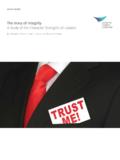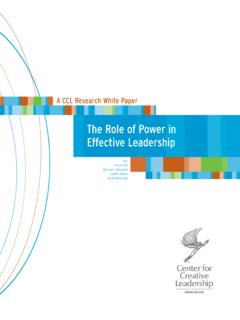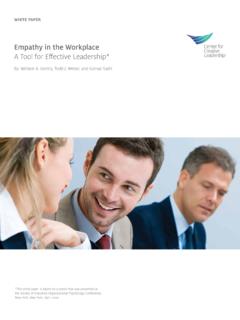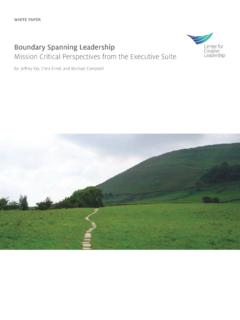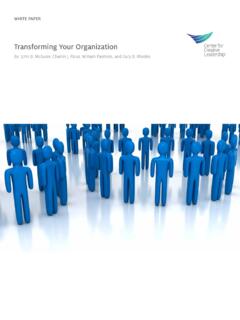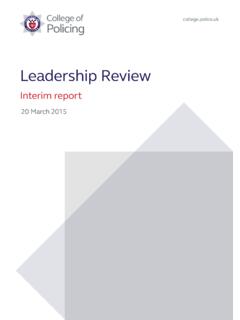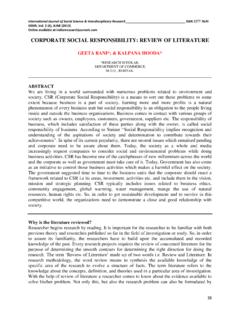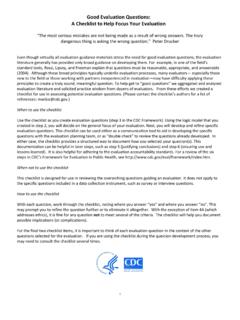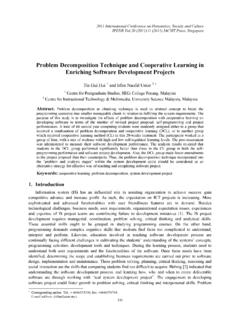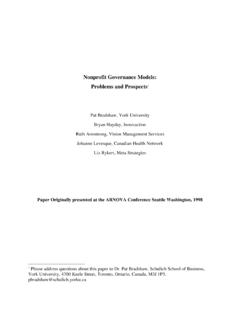Transcription of Corporate Social Responsibility and Sustainable Business
1 Corporate Social . Responsibility . AND Sustainable . Business . A Guide to Leadership Tasks and Functions Alessia D'Amato Sybil Henderson Sue Florence C E N T E R F O R C R E A T I V E L E A D E R S H I P. Corporate Social Responsibility and Sustainable Business A Guide to Leadership Tasks and Functions Corporate Social Responsibility and Sustainable Business A Guide to Leadership Tasks and Functions Alessia D'Amato Sybil Henderson Sue Florence Center for Creative Leadership Greensboro, North Carolina The Center for Creative Leadership is an international, nonprofit educational institution founded in 1970 to advance the understanding, practice, and development of leadership for the benefit of society worldwide. As a part of this mission, it publishes books and reports that aim to contribute to a general process of inquiry and understanding in which ideas related to leadership are raised, exchanged, and evaluated.
2 The ideas presented in its publications are those of the author or authors. The Center thanks you for supporting its work through the purchase of this volume. If you have comments, suggestions, or questions about any CCL Press publication, please contact the Director of Publications at the address given below. Center for Creative Leadership Post Office Box 26300. Greensboro, North Carolina 27438-6300. CCL Stock No. 355. 2009 Center for Creative Leadership All rights reserved. No part of this publication may be reproduced, stored in a retrieval system, or transmitted, in any form or by any means, electronic, mechanical, photocopy- ing, recording, or otherwise, without the prior written permission of the publisher. Published by CCL Press Martin Wilcox, Director of Publications Peter Scisco, Editor, CCL Press Karen Lewis, Associate Editor Joanne Ferguson, Production Editor Cover design by Joanne Ferguson ISBN 978-1-60491-063-6.
3 V Table of Contents Introduction .. 1. Purpose, Method, and Framework for This Publication .. 2. Key Themes .. 3. Approaches to Implementing 4. Drivers of Ongoing 4. Corporate Identity and 5. CSR and 6. Partnering with 7. Leadership Capabilities and 8. Organizational Challenges and 10. Conclusion .. 11. Annotated Bibliography .. 12. Author Index .. 89. Title Index .. 91. 1. Introduction Corporations around the world are struggling with a new role, which is to meet the needs of the present generation without compromising the ability of the next generations to meet their own needs. Organizations are being called upon to take Responsibility for the ways their operations impact societies and the natural environment. They are also being asked to apply sustainability principles to the ways in which they conduct their Business .
4 Sustainability refers to an organization's activities, typically considered voluntary, that dem- onstrate the inclusion of Social and environmental concerns in Business opera- tions and in interactions with stakeholders (van Marrewijk & Verre, 2003). It is no longer acceptable for a corporation to experience economic prosperity in isolation from those agents impacted by its actions. A firm must now focus its attention on both increasing its bottom line and being a good Corporate citizen. Keeping abreast of global trends and remaining committed to financial obligations to deliver both private and public benefits have forced organizations to reshape their frameworks, rules, and Business models. To understand and enhance current efforts, the most socially responsible organi- zations continue to revise their short- and long-term agendas, to stay ahead of rapidly changing challenges.
5 In addition, a stark and complex shift has occurred in how organizations must understand themselves in relation to a wide variety of both local and global stakeholders. The quality of relationships that a company has with its employees and other key stakeholders such as customers, investors, suppli- ers, public and governmental officials, activists, and communities is crucial to its success, as is its ability to respond to competitive conditions and corpo- rate Social Responsibility (CSR). These major transformations require national and global companies to approach their Business in terms of Sustainable development, and both individual and organizational leadership plays a major role in this change. Organizations have developed a variety of strategies for dealing with this intersection of societal needs, the natural environment, and corresponding Business imperatives.
6 Organizations can also be considered on a developmen- tal continuum with respect to how deeply and how well they are integrating Social Responsibility approaches into both strategy and daily operations world- wide. At one end of the continuum are organizations that do not acknowledge any Responsibility to society and the environment. And on the other end of the continuum are those organizations that view their operations as having a significant impact as well as reliance on society at the economic, Social , and ecological levels, thus resulting in a sense of Responsibility beyond the 2 Corporate Social Responsibility and Sustainable Business traditional boundaries of the organization. Most organizations can be placed somewhere in between. Corporate Responsibility or sustainability is therefore a prominent fea- ture of the Business and society literature, addressing topics of Business ethics, Corporate Social performance, global Corporate citizenship, and stakeholder management.
7 Management education can be an important source of new ideas about shifting toward an integrated rather than fractured knowledge economy, but this means also that the role and meaning of socially responsible leader- ship needs to be updated. Much further research is needed to create a clearer understanding of what is required, both in leadership itself and in the field of leadership development. In the following, we present the state of the art of knowledge related to CSR and the role of leadership. We highlight some current developments on this topic and draw attention to similarities and differences in the three angles of the triple bottom line (TBL) the environmental, societal, and Business arenas. The field addresses complex and critical issues, such as human rights, environmental protection, equal opportunities for all, fair competition, and the interdependencies that occur between organizations and society (Quinn, 2008).
8 Ongoing research reveals that a variety of strategies, alliances and partnerships, and approaches are being used around the globe. The literature also reveals that although the aspiration of many corporations to contribute to a better world is great, translating that aspiration into reality proves to be somewhat of a challenge. Purpose, Method, and Framework for This Publication The purpose of this sourcebook is to provide an overview of the academic and Business literature on CSR and leadership. To pull together this anno- tated collection of sources, the authors examined literature on CSR, Corporate citizenship, and sustainability, mainly from 2000 to the present. A snapshot of the current thinking, research, and opportunities for additional scholarship is provided. We used three methods to select an adequate sample of articles and books for review: A systematic search of the academic and professional literature on leadership and CSR, as well as a keyword search using CSR syn- onyms ( , sustainability, Corporate citizenship, Corporate sustain- ability, ethical leadership, Corporate governance, and Corporate Social performance).
9 This strategy retrieved 211 documents. Key Themes 3. A random search of articles and books on CSR. We searched data- bases and library catalogs using keywords such as Corporate Social Responsibility , Corporate citizenship, Corporate sustainability, ethical leadership, and leadership, as well as names of authors. A review of bibliographic references from articles found initially and an examination of class reading assignments from a graduate-level ethics and Social Responsibility course. All references come from scholarly journal articles, articles from the popular press, books, book chapters, and practitioner and expert essays. In most cases, publications were selected that were published from 2000 on- ward, and material was selected that was directly related to one of the themes of CSR. Some not strictly academic articles were retained when they added a different perspective or complemented a theme previously identified.
10 The key themes that emerged through the literature were the following: Approaches to CSR promotion and implementation CSR as Business case versus development CSR and Corporate identity and ethics CSR and accountability Stakeholders' engagement or partnership Leader and leadership capabilities and competencies for CSR. CSR's challenges and limitations Although we did not use a rigorous methodology to derive these themes, we feel they provide a useful way to present an overview of the field and a frame- work for further research and study. Key Themes This section of the book introduces the reader to key themes in the field and refers to the most representative publications for each. This overview does not aspire to provide a comprehensive picture of either the field or the full content of the annotations that follow.


